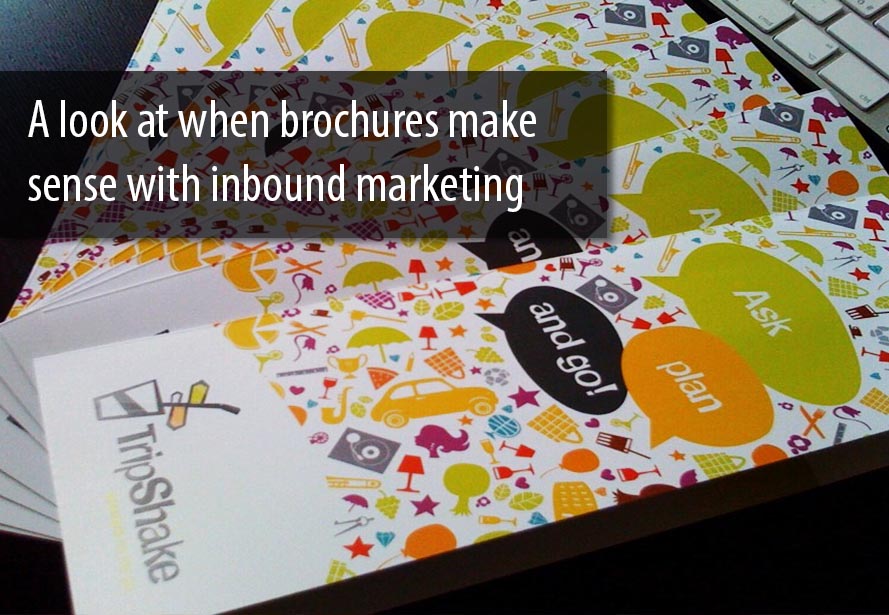Who Is Still Using Marketing Brochures?
WHO IS STILL USING MARKETING BROCHURES?
My Experience with Brochures
Like a stereotypical millennial, I have a hard time doing what I'm told if it doesn't make sense to me. That was the case when I was asked to develop a brochure to market a new product.
The company had put out brochures for all its products and services for time immemorial. But here was the problem: the new product was extremely high tech and sophisticated. Only tech-savvy people would be interested in buying it, and tech-savvy people don’t go browsing through brochures.
So instead of drafting the text, pulling in graphic designers, and sending thousands of copies to print, I did something different.
I called a meeting with all the people involved in developing or using the brochures that included the marketing folks, the sales people, the designers, and the customer service representatives.
Then I filled up a box - yes, a box - with copies of all the brochures on display. Once I had everyone in the room, I spread them over the table like a massive deck of cards. It was a “come to Jesus” moment.
Some of the brochures hadn't been updated since the 1990s. Others looked glaringly out of place because their graphics and taglines were leftovers from outdated marketing campaigns. The majority looked tired, old-fashioned, and ultimately destined for a garbage can.
That's when we started asking the right questions: Is this really the best way for us to reach our audience? Is there something better we could be doing?
Do our print marketing pieces still make sense?
If your company has traditionally relied on brochures to reach your customers, you can probably relate to this situation.
The worst thing you could do for your business is continue using the same marketing tactics year after year without evaluating them. The marketplace has changed, and you need to keep up.
Maybe brochures were once essential to your sales and marketing team, but are they still? It's probably time to ask.
Here's a list of questions your team needs to answer:
- How are we currently using our brochures?
- Where are they distributed?
- Who uses them the most?
- Do our potential customers expect brochures for information about our products or industry?
- What are the benefits of having printed versions of this information?
- What are the drawbacks of having printed versions of this information?
- How frequently are our brochures specifically requested by potential customers?
- How many did we print each year, and how much do they cost?
Depending on how you answer these questions, you'll be looking at one of two options: Either give your brochures a facelift to make them more impactful, or ditch them all together.
Option #1. Give your brochures a facelift.
If you're going to keep brochures, make sure you maximize their benefits to your business. Here are 3 easy ways to make your brochures interactive.
1. Include social media calls-to-action.
Social media calls-to-action are cheap and easy ways to increase engagement. Ask people to “like” or follow you on Facebook, Twitter, or Instagram, and offer some sort of incentive in return. Something as simple as a trackable coupon code can help you measure your brochures’ effectiveness and boost your ROI.
2. Create SEO-optimized versions for your website.
You can increase the reach of your brochures by turning them into SEO-optimized PDFs and uploading them to your site. That way customers can view or download them to get more information about your products and services.
3. Add QR Codes.
Quick Response (QR) Codes look like square dots arranged on a square grid. By simply scanning the code with their smartphones, your potential customers can access your company’s URL, your social media page, a coupon code, or anything else you want.
QR Codes both increase the conversion rate of your brochures and help guide your prospects further down the sales funnel. The best part is that they're trackable, so you can actually measure how much they benefit your company.
Option #2. Ditch your brochures completely.
If your potential customers primarily look for information about your products online, then your information needs to be online, not in a brochure. You need to make the bold decision to completely purge brochures from your business and focus your efforts on developing your digital marketing offers.
But don't just throw your brochures away - repurpose their information into blog posts. The great thing about a blog post is that it lives forever. The search-optimized keywords in your blog will keep drawing new business to your company, which means your blog will never stop benefitting you.
Once you have enough blog posts, you can build them into an informative eBook or a white paper. Unlike brochures which are short and limit how much content you can cover, an e-Book can hold as much information as you want.
And it's much more valuable to your customers and then a pithy brochure, which they'll eventually want to throw away. An e-Book takes up no physical space, and it can be re-accessed through a couple quick clicks.
Plus you can offer it to as many customers as you want without any additional cost to you. No printing, no storing, and no mailing - just useful information in a convenient online format.
Integrating brochures with inbound marketing
Brochures have been around since the birth of the first commercial stores. In the old days of traditional marketing strategies, these glossy, tri-folded pieces of paper were cutting-edge sales and marketing tools.
Today, brochures still have a role to play, but they need to be integrated with your digital marketing efforts to be truly effective.
Key takeaway: Don’t be complacent about your marketing tactics, especially your print marketing pieces. Like we said in our post “Your Marketing Tactics Suck. Here's How to Fix Them,” your tactics need to support your overall marketing strategy. If they aren’t generating business and revenue for your company, it’s time to reevaluate.
Editor's Note: This post was originally published in July 2015 and has been updated for accuracy and comprehensiveness.
Image by Brian Suda via Flickr, licensed under CC BY 2.0.
Share this
You May Also Like
These Related Stories

How to Use Content Marketing to Close More Deals

How to Convince Your Boss to Try Inbound Marketing [SlideShare]



/Accreditations/CRM-Implementation-Accredited-Badges.png?width=170&height=138&name=CRM-Implementation-Accredited-Badges.png)
/Accreditations/Onboarding-Accredited-Badges.png?width=170&height=137&name=Onboarding-Accredited-Badges.png)
/Accreditations/Custom-Integration-Accredited-Badges.png?width=170&height=137&name=Custom-Integration-Accredited-Badges.png)

